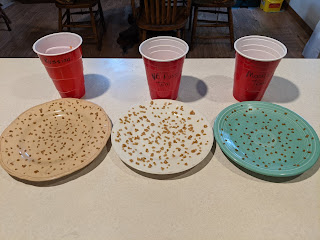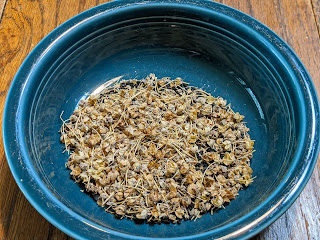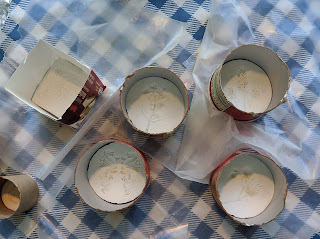I still make homemade soap from time to time, although not as often as I'd like. I belong to a couple of soap making groups on FB and have learned a lot from those folks. One member, a Russian soapmaker who owns a cosmetics business called Lab.Mila, has shared photos of the gorgeous soaps she makes. Look at these beauties:
She is so talented. She makes her own soap molds from silicon, using a technique called bas relief. After drooling (yeah, I know I'm weird) over her pictures and watching a bunch of videos online, I decided to try making my own molds.
Step one - gather materials. I ordered clay, plaster and a silicon molding kit. The total cost was about $50. $35 of that was the silicon kit. This would not be a cheap experiment.
Step two - collect the things you want to show in the relief. You can use whatever you want, as long as it will make a clean mold impression in the clay. I decided to use plants and some jewelry.
Step three - create the clay impression for your mold. This was tricky -- rolling out the clay, trying to get it smooth and even, trying to get the size and shape right, trying to press the plants deep enough but not too deep. I kept telling myself this was just an experiment and it didn't have to be perfect. After I made the clay impressions, I cut them to size and put them inside Pringles cans and butter boxes.
Step four - pour the plaster over the clay impressions to create a plaster cast.
Step five - pop out the hardened plaster casts, and use pottery tools to smooth the rough edges. The square cast came out wonky, because the sides of the butter box were pushed out by the plaster.
Step six - make the silicon molds. First I had to make a mold for the mold. I used foam board as a base, and empty yogurt containers with the bottoms cut out for the sides, for circular molds. I cut the yogurt containers down the side so I could shape them to the size I needed -- about 1/4 inch bigger than the plaster casts. I used a hot glue gun to attach the yogurt cup sides to the foam board base.
Then I put the plaster casts inside the cup, and poured the silicon inside and over the cast. This is really hard to describe, without having photos. Did I take any photos of this part? Nope.
Everything had been going fairly OK up to this point. However, as soon as I poured the silicon in the mold, I realized I had made a big mistake. The hot glue had not had time to harden. The liquid silicon was leaking out the bottoms of the molds. Good thing I had put everything in a tray lined with butcher paper, otherwise I would have had liquid silicon oozing all over my work table.
Step seven - let the silicon harden and pop the molds out. Trim off the extra bits.
Step eight - make soap in the molds. I've yet to do this step.
From the two pounds of silicon I had, I ended up with four molds. I probably could have gotten two more if I hadn't screwed up with the hot glue. So, six molds from $50 is about $8 a mold. The cost would decrease if I bought supplies in bulk, obviously. But I'm not sure I want to spend this much on an occasional hobby. I did enjoy making the plaster casts, as tricky as it was, and might play around with that process a little more.



















































